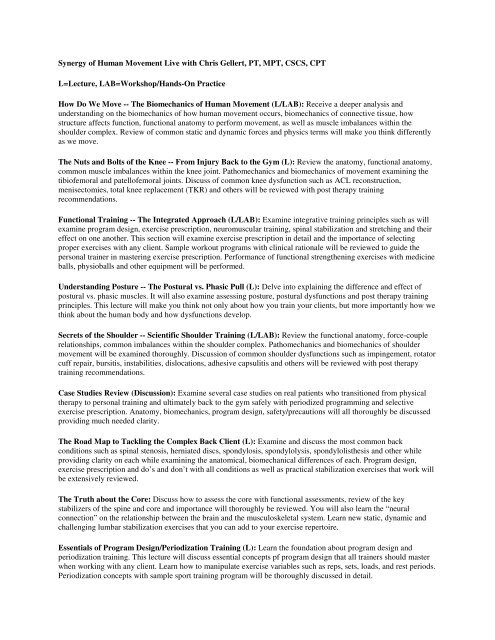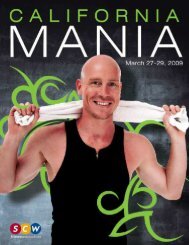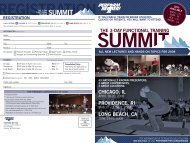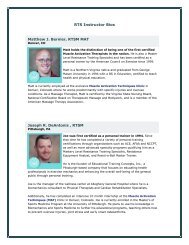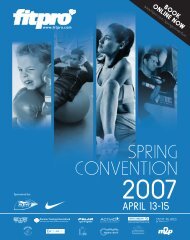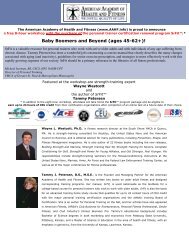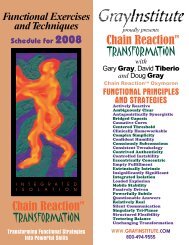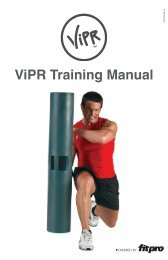Synergy of Human Movement Live with Chris Gellert ... - PTontheNet
Synergy of Human Movement Live with Chris Gellert ... - PTontheNet
Synergy of Human Movement Live with Chris Gellert ... - PTontheNet
- No tags were found...
You also want an ePaper? Increase the reach of your titles
YUMPU automatically turns print PDFs into web optimized ePapers that Google loves.
<strong>Synergy</strong> <strong>of</strong> <strong>Human</strong> <strong>Movement</strong> <strong>Live</strong> <strong>with</strong> <strong>Chris</strong> <strong>Gellert</strong>, PT, MPT, CSCS, CPT<br />
L=Lecture, LAB=Workshop/Hands-On Practice<br />
How Do We Move -- The Biomechanics <strong>of</strong> <strong>Human</strong> <strong>Movement</strong> (L/LAB): Receive a deeper analysis and<br />
understanding on the biomechanics <strong>of</strong> how human movement occurs, biomechanics <strong>of</strong> connective tissue, how<br />
structure affects function, functional anatomy to perform movement, as well as muscle imbalances <strong>with</strong>in the<br />
shoulder complex. Review <strong>of</strong> common static and dynamic forces and physics terms will make you think differently<br />
as we move.<br />
The Nuts and Bolts <strong>of</strong> the Knee -- From Injury Back to the Gym (L): Review the anatomy, functional anatomy,<br />
common muscle imbalances <strong>with</strong>in the knee joint. Pathomechanics and biomechanics <strong>of</strong> movement examining the<br />
tibi<strong>of</strong>emoral and patell<strong>of</strong>emoral joints. Discuss <strong>of</strong> common knee dysfunction such as ACL reconstruction,<br />
menisectomies, total knee replacement (TKR) and others will be reviewed <strong>with</strong> post therapy training<br />
recommendations.<br />
Functional Training -- The Integrated Approach (L/LAB): Examine integrative training principles such as will<br />
examine program design, exercise prescription, neuromuscular training, spinal stabilization and stretching and their<br />
effect on one another. This section will examine exercise prescription in detail and the importance <strong>of</strong> selecting<br />
proper exercises <strong>with</strong> any client. Sample workout programs <strong>with</strong> clinical rationale will be reviewed to guide the<br />
personal trainer in mastering exercise prescription. Performance <strong>of</strong> functional strengthening exercises <strong>with</strong> medicine<br />
balls, physioballs and other equipment will be performed.<br />
Understanding Posture -- The Postural vs. Phasic Pull (L): Delve into explaining the difference and effect <strong>of</strong><br />
postural vs. phasic muscles. It will also examine assessing posture, postural dysfunctions and post therapy training<br />
principles. This lecture will make you think not only about how you train your clients, but more importantly how we<br />
think about the human body and how dysfunctions develop.<br />
Secrets <strong>of</strong> the Shoulder -- Scientific Shoulder Training (L/LAB): Review the functional anatomy, force-couple<br />
relationships, common imbalances <strong>with</strong>in the shoulder complex. Pathomechanics and biomechanics <strong>of</strong> shoulder<br />
movement will be examined thoroughly. Discussion <strong>of</strong> common shoulder dysfunctions such as impingement, rotator<br />
cuff repair, bursitis, instabilities, dislocations, adhesive capsulitis and others will be reviewed <strong>with</strong> post therapy<br />
training recommendations.<br />
Case Studies Review (Discussion): Examine several case studies on real patients who transitioned from physical<br />
therapy to personal training and ultimately back to the gym safely <strong>with</strong> periodized programming and selective<br />
exercise prescription. Anatomy, biomechanics, program design, safety/precautions will all thoroughly be discussed<br />
providing much needed clarity.<br />
The Road Map to Tackling the Complex Back Client (L): Examine and discuss the most common back<br />
conditions such as spinal stenosis, herniated discs, spondylosis, spondylolysis, spondylolisthesis and other while<br />
providing clarity on each while examining the anatomical, biomechanical differences <strong>of</strong> each. Program design,<br />
exercise prescription and do’s and don’t <strong>with</strong> all conditions as well as practical stabilization exercises that work will<br />
be extensively reviewed.<br />
The Truth about the Core: Discuss how to assess the core <strong>with</strong> functional assessments, review <strong>of</strong> the key<br />
stabilizers <strong>of</strong> the spine and core and importance will thoroughly be reviewed. You will also learn the “neural<br />
connection” on the relationship between the brain and the musculoskeletal system. Learn new static, dynamic and<br />
challenging lumbar stabilization exercises that you can add to your exercise repertoire.<br />
Essentials <strong>of</strong> Program Design/Periodization Training (L): Learn the foundation about program design and<br />
periodization training. This lecture will discuss essential concepts pf program design that all trainers should master<br />
when working <strong>with</strong> any client. Learn how to manipulate exercise variables such as reps, sets, loads, and rest periods.<br />
Periodization concepts <strong>with</strong> sample sport training program will be thoroughly discussed in detail.
Exercises that Hurt More than Help (L/LAB): Review several key exercises, stretches, and functional<br />
strengthening exercises that can create or lead to dysfunction and should be avoided. Anatomy, biomechanics and<br />
clinical rationale will all be discussed as <strong>with</strong> attendance participation. This session will make you really think about<br />
exercises that you teach and why they are utilized in training programming.<br />
Nuts and Bolts <strong>of</strong> Neuromuscular Training (L/LAB): Discuss the foundation or motor control and motor learning<br />
which are the foundation <strong>of</strong> learning any new exercise, retraining, improving balance, etc. This in depth lecture will<br />
examine integration <strong>of</strong> body systems reviewing the connection between the neurologic and musculoskeletal system.<br />
The physiology <strong>of</strong> balance and movement will be examined in great detail. Come prepared to really learn and<br />
understand complex information made simple. Learn new static and dynamic balance exercises to add to your<br />
exercise repertoire.


